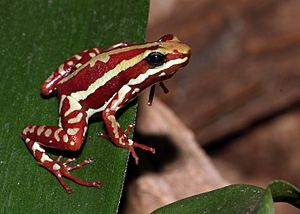Phantasmal poison frog facts for kids
Quick facts for kids Phantasmal poison frog |
|
|---|---|
 |
|
| Phantasmal poison frog compared to a 50 cent euro coin. | |
| Scientific classification | |
| Kingdom: | |
| Phylum: | |
| Class: | |
| Order: | |
| Family: | |
| Genus: |
Epipedobates
|
| Species: |
E. tricolor
|
| Binomial name | |
| Epipedobates tricolor |
|
The phantasmal poison frog (Epipedobates tricolor) is a small, brightly colored frog. It is a type of poison dart frog. These tiny frogs live in the Andean mountains of central Ecuador. Specifically, they are found in the Bolívar province.
Contents
What is a Phantasmal Poison Frog?
The phantasmal poison frog is known for its striking colors. These colors often include bright reds, oranges, yellows, and blacks. These bold patterns are a warning to predators. They tell other animals that the frog is poisonous and should not be eaten.
Size and Appearance
These frogs are very small. They usually grow to be about 2 to 3 centimeters (less than 1.5 inches) long. That's about the size of a paperclip! Their skin is smooth and shiny. The bright colors help them blend into their surroundings, even though they are meant to stand out as a warning.
Where Do They Live?
Phantasmal poison frogs live in the tropical forests of Ecuador. They prefer damp, humid places. You can often find them on the forest floor, among fallen leaves and plants. They need a lot of moisture to keep their skin healthy.
Habitat and Environment
Their home in the Andes mountains is full of lush greenery. The forests provide plenty of hiding spots and food. They live in areas that are not too high up, usually between 1,000 and 1,800 meters (about 3,300 to 5,900 feet) above sea level.
What Do They Eat?
Phantasmal poison frogs are insectivores. This means they mostly eat insects. Their diet includes tiny ants, termites, and other small bugs. They use their long, sticky tongues to catch their prey.
How They Find Food
These frogs are active during the day. They hunt for food on the forest floor. Their excellent eyesight helps them spot tiny insects moving around.
How Do They Protect Themselves?
The phantasmal poison frog gets its name from its poison. Their skin produces a powerful toxin. This poison can make predators very sick or even kill them. This is their main way of defending themselves.
The Poison's Origin
Interestingly, these frogs do not make their own poison. They get it from the insects they eat! The insects eat certain plants or fungi that contain toxins. When the frog eats these insects, the toxins build up in the frog's skin. This is why frogs raised in captivity without these specific insects are not poisonous.
Reproduction and Life Cycle
The life cycle of the phantasmal poison frog is fascinating. Like all frogs, they start as eggs and go through different stages.
Laying Eggs
Female frogs lay their eggs on land, usually on leaves or in small, damp places. The eggs are often protected by the male frog. He guards them until they hatch.
Tadpoles to Frogs
Once the eggs hatch, tiny tadpoles emerge. The male frog then carries the tadpoles on his back to a small pool of water, like a water-filled plant or a small puddle. The tadpoles grow and develop in the water. They eat algae and small bits of plant matter. After some time, they transform into tiny froglets, losing their tails and growing legs. Finally, they become adult frogs.
Conservation Status
The phantasmal poison frog faces some challenges. Their habitat is sometimes threatened by human activities. Scientists and conservationists work to protect these unique frogs and their homes.
See also
In Spanish: Epipedobates tricolor para niños


